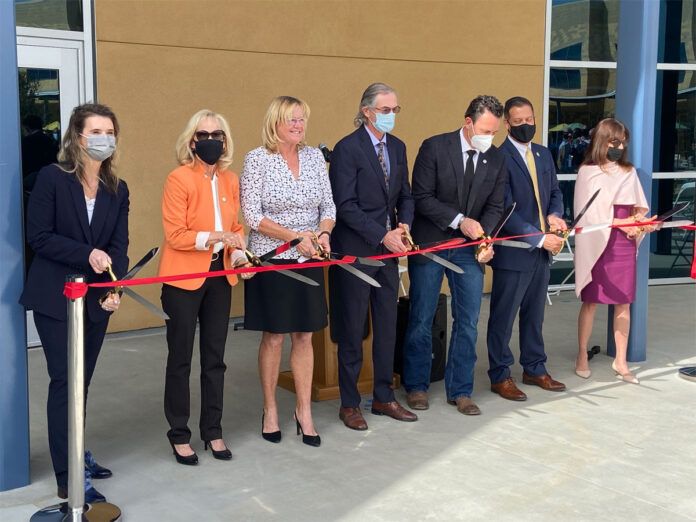
The County of San Diego held the grand opening of its new Youth Transitional Campus in Kearney Mesa on Jan. 28. This new facility is a re-imagination of the future of juvenile detention, designed to be less like outdated correctional facilities, and designed to promote positive youth development and staff wellbeing. The design of the facility and the operating approach follows the Youth in Custody Practice Model designed by national experts from Georgetown University’s Center for Juvenile Justice Reform and the Council of Juvenile Justice Administrators.
The Campus was transformed from its 1950s-era facility and built across 12 acres for youth 13 – 20 years old. Eight housing units that accommodate 96 beds are organized along an arching tree-lined pathway with an open courtyard that includes basketball courts, handball courts, garden space and an amphitheater and stage.
Along the other side of the courtyard is the main large visitation and dining building that includes a state-of-the-art culinary art working kitchen, and a standalone school complex with a career technical education building, and an indoor gymnasium. The residential living units have high wood beam ceilings, large open areas with home-like finishes, and mental health clinicians in each unit. The next phase of construction, set to begin in the spring and will include a 72-bed Temporary Residential Placement Facility, previously known as Juvenile Hall, and a small office building to support Probation staff and families.
Youth Development and Community Support Services Division Executive Deputy Chief Probation Officer Scott Huizar has been doing probation work in the county for the past 27 years, with most of his career focused on youth. He said they have had an outdated correctional facility in San Diego, with the old Juvenile Hall built in the 1950s. He said over the course of the past six to seven years, their vision was to develop a state-of-the-art facility to align with National Best Practices.
“Under the guidance of the San Diego County Board of Supervisors, we went across the nation and up and down the state to see what programs that had offer and wanted to provide and opportunity for our staff, including line staff and labor representatives, an opportunity to see what else was out there.”
Huizar said the purpose of that was to see other programs and facilities that have national recognition, and “pick and choose” the national best practices and bring it to this facility in San Diego.
“I think we did an excellent job of what we wanted to highlight and emphasize, and we have seen that in the new facility here in San Diego,” he said. “We aligned national best practices related to not only the living environment, but also the staffing environment. We want to make sure our staff have a great working environment and make sure that they are taken care of, because they are our front line workers providing daily interaction and engagement with our youth. We wanted them to be able to have that meaningful productive engagement in relationship with the youth, so we can foster that positive reinforcement with them.”
Huizar said they focused on staffing, living environment for youth, education, programs and services, collaboration with behavioral health, and top quality medical services.
“Everything we have developed in the new facility, there are bits and pieces from other programs all across the country,” he said.
Huizar said it has coordinated its efforts with collaborative providers, community based providers, as well as its educational staff with the San Diego Office of Education.
“Unlike many other institutional facilities, we not only have a stand-alone educational campus, but we also have a stand-alone Career Technical Education program,” he said. “We have woodworking, potentially silk screening, and a state-of-the-art culinary arts program where we can teach the kids the trades of the craft for culinary arts. We have a stand-alone working culinary arts kitchen to provide our kids the opportunities for learning, providing them meaningful, livable wages upon their release from custody.”
Huizar said the facility has eight housing dorms, with each dorm containing 12 beds. He said this also includes a supervisor’s office, a clinician’s office for behavioral health, unlike in the past, so youth can have private in-house services. He said in addition, there is a picnic outside area, patio area, two designated seating areas for youth, updated classrooms, laundry facilities in each dorm so the youth have the ability and responsibility to do their own laundry. He said the educational campus is the heart of the facility and that they new gym would rival any high school gym.


